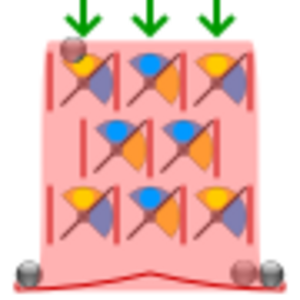Think-a-Dot facts for kids
The Think-a-Dot was a fun toy from the 1960s. It was invented by Joseph Weisbecker and made by E.S.R., Inc.. This toy helped show how simple machines, called automata, work.
What is the Think-a-Dot?
The Think-a-Dot had eight colorful disks on its front. It also had three holes on top: one on the left, one on the right, and one in the middle. You would drop a small metal ball, called a ball bearing, into one of these top holes.
Each disk could show either a yellow or a blue side. This depended on how a special part inside the toy was tilted. Because there were eight disks, and each could be in one of two positions, the Think-a-Dot had 256 different ways it could be set up inside!
How Does it Work?
When a ball dropped into the Think-a-Dot, it would travel down through the toy. As the ball passed by a disk, it would flip that disk's mechanism. This flip would change the disk's color from yellow to blue, or blue to yellow.
The way the disks were set up also decided where the ball would go next. Each disk would guide the ball either to the left or to the right. Finally, the ball would exit the toy from a hole on either the left or the right side at the bottom.
Puzzles and Games
The Think-a-Dot was more than just a toy; it was a puzzle! You could play different games with it. For example, you might try to flip all the disks to a certain color using the fewest ball drops. Or, you could try to get the disks into a specific pattern starting from all yellow or all blue. It was a clever way to explore how simple rules can lead to complex outcomes.


